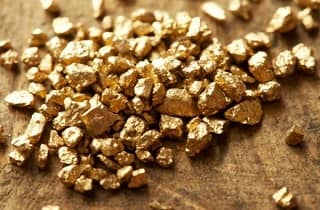The history of gold
Gold comes from the Sanskrit word Jval and the Anglo-Saxon word Gold. The chemical symbol for gold is derived from the Latin word, aurum. An attractive and highly valuable metal, gold has been discovered for at least 5,500 years. Gold is sometimes found in nature but is usually found in association with silver, quartz (SiO2), calcite (CaCO3), lead, tellurium, zinc or copper.Gold mining currently costs more than the gold is worth. Gold is the most malleable and malleable of all metals discovered. One ounce of gold can be turned into a sheet of approximately 5 meters. Thin gold sheets, known as gold leaf, are mainly used in jewelry and industry. A gold sheet can be made to a thickness of 0.000127 mm.
Gold is malleable and shiny, making it a good metalworking material. Chemically, gold is a conductive metal. Conductive metals are unique because they can bond with other elements not only using their outermost shell of electrons (negatively charged particles orbiting the nucleus of an atom), but also with their outermost two shells.

Gold is a small fraction of the known elements in the universe. The reason it is rare is because of the incredible amount of energy required to form it. According to the journal PNAS, gold forms in stars, but only in those that explode in giant supernovae. From Europe to the Middle East to the tombs of Egyptian pharaohs, gold appears throughout the ancient world. According to Australian research sources, five thousand years ago, the Nile River was more influential than any other factor in the emergence of civilization in ancient Egypt. Its water allowed a large amount of crops to be grown next to it and fed its citizens and army. But there was also a shiny yellow metal coming down the river, gold. Egyptians eagerly sought out this visually appealing treasure, finding that because it was naturally pure and malleable, it needed only a little modification to be transformed into mesmerizing ornaments. Gold as an ornament did not stop in ancient Egypt: a Stone Age woman buried near London had a gold necklace around her neck. The golden tooth was discovered among the Celtics in the third century BC. King of China who died in 128 BC. It was buried with gilded chariots and thousands of other precious objects. Gold quickly became a symbol and a unit of wealth, and has retained this appeal throughout time and around the world.

Roman Ghirshman mentions in the book "Iran from the beginning to Islam" that gold was mined in the Medes era and around the modern city of Hamadan. A large amount of copper, iron, gold, silver, lead and arsenic have been found in the mountains chosen by the Medes to live, which shows the ancient history of gold in Iran. This statement was quoted by Will Durant in the book Orient of Civilization. A book that reviews the history of civilization in an attractive way and has sold millions of copies in the world.
Strabo, as one of the Greek geographers, also mentions that civilizations were formed in ancient Iran that were based on minerals and rare metals. The incident that has caused Iran to be full of all kinds of treasures today. In the year 455 to 531 AH, various products such as gold, silver, pearls, glass, iron, copper, mercury, coral and amber were found in the city of Tisfon, the capital of the Sassanids. Archaeologists believe that gold has been prevalent in Iran since the third millennium BC.
Throughout history, many gold and silver mines have been discovered in Iran. Shah Abbas Safavi also prevented this work due to the fact that the expenses of mining were more than its income.


